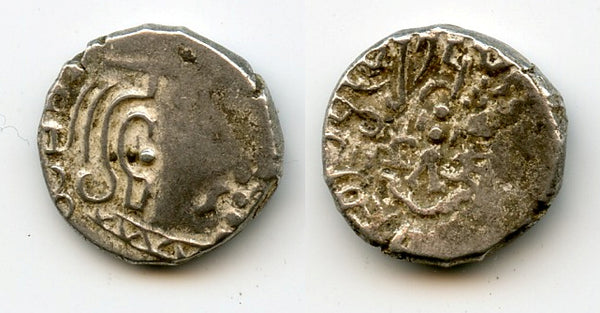
Silver drachm, Kumaragupta (c.407-51 CE), mint 1 (Vadodara?), Gupta Empire, India (F/T G5e)
Bust of king, right, completely corrupt Greek inscription around / Formalized Garuda standing facing with spread wings. In Brahmi Parama-bhagavata maharajahiraja Sri Kumaragupta Mahendraditya ("Absolutely holy King of Kings Lord Kumaragupta Mahendraditya"). 14mm, 2.10 grams. Mint 1 in Gujarat (Vadodara?). Todd/Fishman "The Silver Coinage of the Gupta Empire and Associated States in Western India" (2024) #G5e.
"Mint 1" was the first mint taken by the Guptas from the Kshatrapas (around 398 CE). It is speculated to be Vadodara or perhaps Khambhat in Gujarat. This is a mid-period type, probably the last one on which Kumaragupta is given the title of a Maharajahiraja (on later ones he was "demoted" to Rajadhiraja), minted c.420s-430's.
The silver coinage of the Gupta Empire is notoriously complex, with numerous issues bearing similar legends yet struck to varying standards of weight and metal content. In their recent work The Silver Coinage of the Gupta Empire and Associated States in Western India (2024), Todd and Fishman undertook a comprehensive reclassification of the series, bringing much-needed order to this challenging field of study. The present coin is attributed in accordance with the system set out in their catalogue.
Kumaragupta I (Mahendraditya) was a ruler of the Gupta Empire in 415-455 CE. Like his father and predecessor, Chandragupta II, Kumaragupta was an able ruler. He retained, intact, the vast empire, which extended from Bengal to Kathiawar and from the Himalayas to the Narmada. He issued silver coins in the style of the newly conquered Western Kshatrapas, though the Kshatrapa symbols on the reverse were replaced with the Gupta symbol Garuda.
